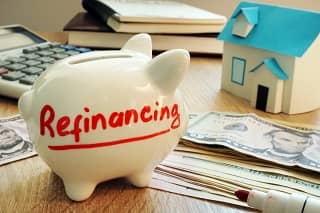Getting a handle on refinance mortgage rates
Mortgage rates are influenced at several levels--from worldwide economic events, which you have no control over, to your credit rating, which you can control.
Here are the factors--from large to small--that determine refinance mortgage rates.
The Economy
Interest rates, including mortgage rates, move with the economy.
"When the economy is weak, and inflation is low or falling, people tend to move into conservative investments like bonds," says Keith Gumbinger, vice president of HSH.com. "This demand drives bond prices higher and yields lower, and serves to influence mortgage rates downward. The lowest mortgage rates often come amid the bleakest economic conditions."
For example,a rougher economic climate in the Eurozone and the effects of the U.S. trade "war" with China have slowed global economic growth and unnerved investors, who in turn have moved money to American bonds as safe investments. This demand for safety and security helps lower U.S. interest rates, especially at a time when many government bonds in developed economies have negative yields (essentially, investors need to pay the bond seller for the privilege of holding their money out of harm's way).
Mark Greenberg of Wealth & Tax Planners in Walnut Creek, Calif., says, "Long term rates are set by the 'market' (traders, banks, etc., i.e. the participants' collective wisdom about where rates should be). Mortgage rates, he explains, tend to follow the rates on 1, 5 and 10-year Treasury notes.
"As demand pushes bond prices up, they cost more, so they yield less (investors pay more for the same dividend amount). The converse is also true."
The Fed
Reading the financial news, it's easy to think that if your mortgage rate went up, it's because the Fed "raised" interest rates. That's simply not the way it works.
Savings institutions are required to maintain a certain level of deposits, called reserves, with the Federal Reserve Bank, to make sure that there is money to pay depositors when they want it. The Fed supervises overnight loans of these reserves from one bank to another to cover fluctuating needs for cash.
So when the Federal Reserve "changes" the rate on these loans (called the Federal Funds rate), it simply uses its control over the supply of money to influence rates. It can't dictate what banks charge, and the Fed's influence over short-term rates does not extend to mortgage rates.
"Unlike direct purchases of MBS which the Fed did in (QE1), the Fed's purchases of Treasury debt (QE2) wasn't specifically aimed at adding liquidity to mortgage markets in hopes of lowering mortgage rates directly," says Gumbinger. "Rather, it was expected that there would be some beneficial market-related effect as investors sought out higher-yielding, but riskier assets, including mortgage backed-securities. While the Fed's program may have helped some other interest rates to decline or stocks to rise, there was not much overall effect on mortgage rates." Note: QE3 was back at it again, though, with $40 billion per month of direct MBS purchases and was intended to manipulate mortgage rates lower.
Related: Learn how the Federal Reserve's latest actions may affect mortgage rates
Lender Pricing Policy
The Fed doesn't get to set mortgage rates; individual lenders do that. The rates they set depend on several factors:
The pipeline: Mortgage lenders constantly evaluate the amount of business coming in and adjust their rates accordingly. When they have more business than they can comfortably process, they raise rates to stem the flow. When they want to beef up their business, they lower rates to bring in more loans. That's one reason rates differ from lender to lender.
Lender efficiency: Like all businesses, some lenders are better at originating mortgages than others and can operate on smaller margins. That translates to lower rates for their customers.
Lender perception of risk: Some lenders charge more to do loans they consider less desirable. For example, jumbo loans, loans on certain types of properties or in certain parts of the country. Others evaluate risk differently.
This is one factor you do have control over--you can't set lender prices, but you can compare current mortgage rates between lenders and go with the one that offers the best refinance rate to you.
Your Risk Profile
Finally, you determine the refinance rate you are offered. The strength of your refinance application influences the mortgage rate lenders are willing to offer you. Your credit rating and home equity have significant impact on what you pay.
For example, on a conventional Fannie Mae mortgage, a borrower with a 640 credit score needing a 90 percent refinance mortgage pays customary fees plus an extra 2.75 percent in risk-based pricing adjustments (about 0.75% increase in the rate if not paid in cash). Refinancing with less than 20 percent home equity also means the addition of mortgage insurance premiums, which increase your annual percentage rate (APR). Upping your credit score by as little as 1 to 20 points can save you thousands. There's a lot to know about about how risk-based mortgage pricing affects the rates and fees you'll get.
Your Loan Choice
Your choice of loan also influences your mortgage rate. It would take a lot of movement in the economy to see 30-year fixed mortgage rates come down a full percentage point
But by choosing a 15-year fixed loan or a hybrid ARM fixed for 3, 5, 7, or 10 years, you could drop your rate by 0.5 percent to over 1 percent. And you can minimize what you pay by shopping and comparing quotes from several lenders. Mortgage quotes between lenders vary anywhere from 0.375 percent to 0.625 percent. That's money you don't need to leave on the table.
Related links :
- HSH.com on the latest move by the Federal Reserve
- 8 ways to raise your credit score to get a lower mortgage rate



